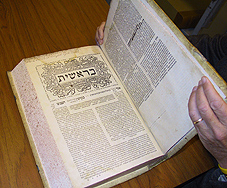Berkeleyan
Bancroft adds rare Hebrew Bible
Second Biblia Rabbinica a key text in history of biblical scholarship
![]()
| 29 September 2005
 The four volumes of the Biblia Rabbinica obtained by Berkeley contain elaborate woodcut illustrations that surround the beginning word of many of its 24 books. |
Paul Hamburg, librarian for Berkeley's Judaica collections, said there are likely only a dozen sets left in the world of the four-volume Second Biblia Rabbinica, including half a dozen or so in private ownership. The edition now housed in the Bancroft Library's rare-book collection, purchased at a New York City auction, is the only one of its kind on the West Coast. (The University of Pennsylvania has one, the University of Chicago another.)
"These volumes are important as a text in the history of biblical scholarship and in the history of the Hebrew book as a masterpiece of Hebrew printing," said Hamburg.
"It should be especially inspiring for our students of the Bible to be able to see these illuminating volumes with their own eyes," said Robert Alter, director of Jewish studies at Berkeley, a professor of Hebrew and comparative literature, and author of The Five Books of Moses: A Translation With Commentary.
The Hebrew Bible contains the Torah (the books of Genesis, Exodus, Leviticus, Numbers, and Deuteronomy); the Nevi-im, writings of the early and later prophets; and other writings, known collectively as the Ketubim, which include Psalms, the books of the Megilot (e.g., Ruth and Ecclesiastes), and related material. The first printed Hebrew Bible was published in 1488.
The First Biblia Rabbinica, published in Venice in 1517 by Daniel Bomberg, was edited - with backing from the Pope - by Felix Pratensis, a Jew who had converted to Christianity. Working with old Hebrew manuscripts, he assembled biblical texts and medieval rabbinical commentaries on those texts, which were used by both Hebrews and Christians to understand biblical scripture at the time, said Ronald Hendel, professor of Near Eastern studies and author of Remembering Abraham: Culture, Memory and History in the Hebrew Bible.
Funding the quest for accuracy
Several years later, scholar Jacob ben Hayim ibn Adoniyahu of Tunis convinced Bomberg that they could produce a new, more complete and accurate version. With funding from Bomberg, ben Hayim searched out and purchased manuscripts from around the world that were considered more reliable than those that had been available to Pratensis.
When completed in 1525, the Second Hebrew Bible presented for the first time the complete Masorah, the extensive Jewish tradition concerning the correct Hebrew text of the Scriptures accumulated over centuries. It also contained ben Hayim's introduction to the Masoretic text. "That introduction remains a classic text in the history of biblical scholarship and the critical study of the Masorah," said Hamburg.
In addition, the Second Biblia Rabbinica has the Targum Onkelos, a classic Aramaic translation of the Bible, as well as more medieval Hebrew commentaries by rabbis than the first rabbinic Bible contained.
"Over the next 400 years, subsequent editions of the Hebrew Bible included more and more commentaries," Hamburg said, "but the Masoretic text and the accompanying critical apparatus compiled by Jacob ben Hayim was preserved."
The Second Biblia Rabbinica was purchased with the financial support of the Geballe and Osher Family Foundations, with the help of Phyllis Cook, executive director of the Jewish Community Federation Endowment Fund, in partnership with the Bancroft Library and UC Berkeley Collections Fund.

